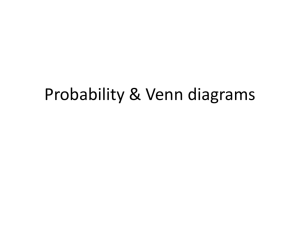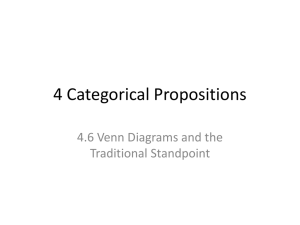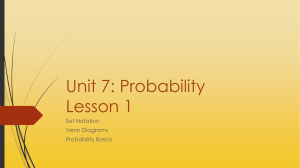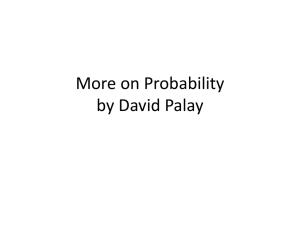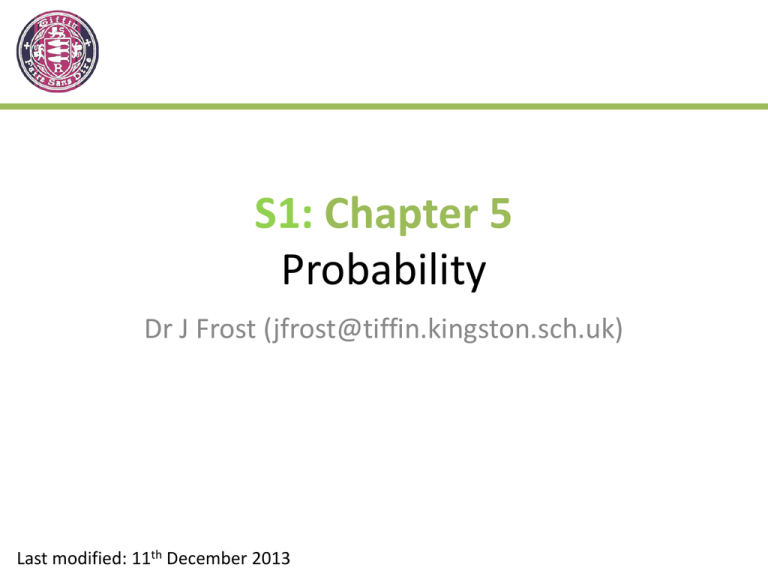
S1: Chapter 5
Probability
Dr J Frost (jfrost@tiffin.kingston.sch.uk)
Last modified: 11th December 2013
Starter
Draw a sample space (using a table) for throwing two dice and
recording the product of the two values.
What is the probability of the value being greater or equal to 24?
Die 1
×
Die 2
1
2
3
4
5
6
1
1
2
3
4
5
6
2
2
4
6
8
10
12
3
3
6
9
12
15
18
4
4
8
12
16
20
24
5
5
10
15
20
25
30
6
6
12
18
24
30
36
?
𝑃 𝑃𝑟𝑜𝑑𝑢𝑐𝑡 ≥ ?
24 =
6
1
=
36 6
Some fundamentals
An experiment is:
A repeatable process that gives rise to a number of
?
outcomes.
A sample space is:
The set of possible outcomes of an experiment.
e.g. The sample space 𝑆 of throwing two coins:
?
𝑆 = 𝐻𝐻, 𝐻𝑇,?𝑇𝐻, 𝑇𝑇
Some fundamentals
𝑃 𝑒𝑣𝑒𝑛𝑡 = 0.3
?
An event is a set of (one or more)
outcomes.
𝑺
𝑨
𝑆 = the whole sample
space
𝑩
3
4
1
2
6
5
𝐴 = even number on
a die thrown
𝐵 = prime number on
a die thrown
Some fundamentals
𝑺
𝑨
𝑆 = the whole
sample space
𝑩
3
4
1
2
6
5
What does it mean in this
context?
𝐴′
𝐵 = prime
number on a die
thrown
What is the resulting set
of outcomes?
Not A.
i.e. Not rolling an even number.
?
𝐴 = even number
on a die thrown
{1, 3,?5}
𝐴∪𝐵
A or B. i.e. Rolling an even
or prime number.
?
{2,3,4,5,6}
?
𝐴∩𝐵
A and B. i.e. Rolling a number
which is even and prime.
{2}?
?
Some fundamentals
𝑺
𝑨
𝑆 = the whole
sample space
𝑩
3
4
1
2
6
5
What does it mean in this
context?
𝐴 = even number
on a die thrown
𝐵 = prime
number on a die
thrown
What is the resulting set
of outcomes?
𝐴 ∩ 𝐵′
Rolling a number which is
even and not prime.
{4,6}
?
(𝐴 ∪ 𝐵)′
Rolling a number which is
not [even or prime].
{1}?
′
Rolling a number which is
not [even and prime].
{1,3,4,5,6}
?
𝐴∩𝐵
?
?
?
What area is indicated?
A
C
B
S
𝐴 ∩? 𝐵
What area is indicated?
A
C
B
S
𝐴 ∪? 𝐵
What area is indicated?
A
C
B
S
𝐴 ∩ 𝐵? ∩ 𝐶
What area is indicated?
A
C
B
S
𝐴 ∩? 𝐶 ′
What area is indicated?
A
C
B
S
𝐴 ∩ 𝐵? ∩ 𝐶 ′
What area is indicated?
A
C
B
S
′
?′
𝐴 ∩𝐵 ∩𝐶
′
or
alternatively…
𝐴 ∪ 𝐵? ∪ 𝐶
′
What area is indicated?
A
C
B
S
𝐴?′
What area is indicated?
A
C
B
S
𝐴 ∩ 𝐵? ∩ 𝐶
′
Solving problems using Venn Diagrams
A vet surveys 100 of her clients. She finds that
25 own dogs, 15 own dogs and cats, 11 own dogs and tropical fish, 53 own cats, 10 own
cats and tropical fish, 7 own dogs, cats and tropical fish, 40 own tropical fish.
Fill in this Venn Diagram, and hence answer the following questions:
a) 𝑃 𝑜𝑤𝑛𝑠 𝑑𝑜𝑔 𝑜𝑛𝑙𝑦
b) 𝑃 𝑑𝑜𝑒𝑠 𝑛𝑜𝑡 𝑜𝑤𝑛 𝑡𝑟𝑜𝑝𝑖𝑐𝑎𝑙 𝑓𝑖𝑠ℎ
c) 𝑃(𝑑𝑜𝑒𝑠 𝑛𝑜𝑡 𝑜𝑤𝑛 𝑑𝑜𝑔𝑠, 𝑐𝑎𝑡𝑠, 𝑜𝑟 𝑡𝑟𝑜𝑝𝑖𝑐𝑎𝑙 𝑓𝑖𝑠ℎ)
𝑺
𝑪
35
100
11
100
?
8
100
?
𝑫
6
100
?
Dr Frost’s cat
“Pippin”
7
100
4
100
?
?
3
100
?
26
100
?
𝑭
Exercises
Page 84 Exercise 5B
Q6
Recap
If 𝐴 and 𝐵 are mutually exclusive, this means:
they can not happen?at the same time.
𝐴
𝐵
On a Venn Diagram…
the circles appear
separately.
?
If 𝐴 and 𝐵 are independent, this means:
one does not affect the other.
Note that these 2 things are ENTIRELY DIFFERENT, they are not ‘opposites’. If 𝐴
and 𝐵 are not mutually exclusive, that doesn’t
? necessarily mean they are
independent.
The Venn Diagram is NOT AFFECTED BY INDEPENDENCE.
Recap
If events A and B are mutually exclusive, then:
𝑃 𝐴 ∪ 𝐵 = 𝑃 𝐴 +? 𝑃(𝐵)
𝑃 𝐴∩𝐵 =0
?
If events A and B are independent, then:
𝑃 𝐴∩𝐵 =𝑃 𝐴 ×𝑃 𝐵
But we’re interested in how we can calculate probabilities when events are not
mutually exclusive, or not independent.
Addition Law
Mutually Exclusive
𝑨
𝑩
Think about the areas…
𝑃 𝐴 ∪ 𝐵 = 𝑃 𝐴 + ?𝑃(𝐵)
Not Mutually Exclusive
𝑨
𝑃 𝐴 ∪ 𝐵 = 𝑃 𝐴 + 𝑃 𝐵? − 𝑃 𝐴 ∩ 𝐵
𝑩
Example
𝐴 and 𝐵 are two events such that 𝑃 𝐴 = 0.6, 𝑃 𝐵 = 0.7 and 𝑃 𝐴 ∪ 𝐵 = 0.9.
Find:
𝑃 𝐴 ∩ 𝐵 = 0.4?
𝑃 𝐴′ = 0.4?
′
𝑃 𝐴 ∪ 𝐵 = 0.8
?
𝑃 𝐴′ ∩ 𝐵 = 0.3
?
Bro Tip: You could use a
Venn Diagram here.
Check your understanding
The events 𝐸 and 𝐹 are such that
𝑃 𝐸 = 0.28 𝑃 𝐸 ∪ 𝐹 = 0.76
Find
a) 𝑃 𝐸 ∩ 𝐹 = 0.17
?
b) 𝑃 𝐹 = 0.65
?
c) 𝑃
𝑺
𝐸′
𝐹′
𝑬
=
𝑃 𝐸 ′ ∩𝐹′
𝑃 𝐹′
0.24
0.35
=?
=
𝑃 𝐸 ∩ 𝐹 ′ = 0.11
24
35
𝑭
Click to0.11
reveal0.17
Venn0.48
Diagram
0.24
Bro Tip: Venn Diagrams
can typically be used when
you have intersections
involving ‘not’s.
Exercises
Page 86 Exercise 5C
Q1, 3, 5
Conditional Probability
Think about how we formed a probability tree at GCSE:
P 𝐵|𝐴
?
𝑃 𝐴
𝐵
𝑃 𝐴∩𝐵
= 𝑃 𝐴 ×?𝑃 𝐵 𝐴
𝐴
𝐵′
𝐵
𝐴′
𝐵′
Alternatively:
𝑃 𝐴∩𝐵
?
𝑃 𝐵𝐴 =
𝑃 𝐴
Bro Tip: You’re dividing
by the event you’re
conditioning on.
Quickfire Examples
Given that P(A) = 0.5 and 𝑃 𝐴 ∩ 𝐵 = 0.3, what is P(B | A)?
𝑷 𝑩 𝑨? =
𝑷 𝑨∩𝑩
𝟎. 𝟑
=
= 𝟎. 𝟔
𝑷 𝑨
𝟎. 𝟓
Given that P(Y) = 0.6 and 𝑃 𝑋 ∩ 𝑌 = 0.4, what is 𝑃 𝑋 ′ 𝑌 ?
P(X’ | Z) = 1 – P(X | Z)?= 1 – (0.4/0.6) = 0.33
Given that P(A) = 0.5, P(B) = 0.5 and 𝑃 𝐴 ∩ 𝐵 = 0.4, what is 𝑃 𝐵 𝐴′ ?
(Hint: you’ll likely need a Venn Diagram for this!)
𝑷 𝑩 𝑨′ = 𝑷(𝑨′ ∩ 𝑩)/𝑷 𝑨′
= 0.1 / 0.5
?
= 0.2
Bro Tip: Note that P(A | B’) + P(A’ | B’) = 1
It is NOT in general true that:
P(A’ | B’) = 1 – P(A | B)
Summary so far
If events 𝑨 and 𝑩 are independent.
P 𝐴 ∩ 𝐵 = 𝑃 𝐴 ×? 𝑃 𝐵
P 𝐴 𝐵 = 𝑃(𝐴) ?
If events 𝑨 and 𝑩 are mutually exclusive:
?
P 𝐴∩𝐵 =0
P 𝐴 ∪ 𝐵 = 𝑃 𝐴 +? 𝑃 𝐵
In general:
P 𝐴𝐵 =
𝑃 𝐴∩𝐵
𝑃 𝐵
?
P 𝐴 ∪ 𝐵 = 𝑝 𝐴 + 𝑝 𝐵 ?− 𝑝 𝐴 ∩ 𝐵
More difficult Venn Diagrams based on mutual exclusivity
(Page 102) Events 𝐴, 𝐵 and 𝐶 are defined in the sample space 𝑆 such that 𝑝 𝐴 = 0.4,
𝑝 𝐵 = 0.2, 𝑃 𝐴 ∩ 𝐶 = 0.04 and 𝑃 𝐵 ∪ 𝐶 = 0.44. The events 𝐴 and 𝐵 are mutually
exclusive and 𝐵 and 𝐶 are independent.
a) Draw a Venn Diagram to illustrate the relationship between the three events and the
sample space. [We’ll work out the probabilities later]
𝑆
𝐴
𝐶
𝐵
?
Key Points:
• Recall that only
mutual
exclusivity
affects the
Venn Diagram.
• You will lose a
mark if you
forget the
outer
rectangle.
More difficult Venn Diagrams based on mutual exclusivity
(Page 102) Events 𝐴, 𝐵 and 𝐶 are defined in the sample space 𝑆 such that 𝑝 𝐴 = 0.4,
𝑝 𝐵 = 0.2, 𝑃 𝐴 ∩ 𝐶 = 0.04 and 𝑃 𝐵 ∪ 𝐶 = 0.44. The events 𝐴 and 𝐵 are mutually
exclusive and 𝐵 and 𝐶 are independent.
b) Find 𝑷(𝑩|𝑪), 𝑷(𝑪), 𝑷 𝑩 ∩ 𝑪 , 𝑷 𝑨′ ∩ 𝑩′ ∩ 𝑪′ , 𝑷 𝑪 ∩ 𝑩′
𝑆
0.36
?
𝑃 𝐵 𝐶 = 0.2?
𝐵
𝐶
𝐴
𝑃 𝐶 = 0.3
?
0.04
?
Bro Tip: Use the last sentence
about mutual
exclusivity/independence to
immediately write out some extra
information, e.g.
𝑃 𝐵 ∩ 𝐶 = 0.2𝑃(𝐶)
0.2
?
0.06
?
𝑃 𝐴′ ∩ 𝐵′ ∩ 𝐶 ′ = 0.2?
0.14
?
𝑃 𝐶 ∩ 𝐵′ = 0.24
?
June 2013
Answer to (d):
11
=
20
?
=
3
=
8
?
99
100
?
?
=
1
4
?
Exercises
Provided sheet of past paper questions!
Exercises (on worksheet)
b
P(A u B) = P(A) + P(B) – P(A
? n B) = 0.67
P(A’ | B’) = P(A’ n B’) / P(B’) = 0.33 / 0.55 = 0.6
(We can see that P(A’ n B’) = 1 – P(A u B) ?
by a quick sketch of a Venn Diagram)
c
P(B n C) = P(B)P(C) = 0.09 (we can directly?multiply because they’re independent)
a
0.22
d
0.22
A
0.13
0.09
?
0.23
B
e
0.11
C
S
Using a Venn Diagram, we can see
that:
?B’) + P(A’ n B’ n C’)
P([B u C]’) = P(A n
= 0.22 + 0.22 = 0.44
Exercises (on worksheet)
a
b
c
d
e
B and W, or T and W. Because
the circles don’t overlap/the
events can’t happen at the
same time.
?
P(B n T) = 5/25 = 1/5
P(B)P(T) = 9/25 x 8/25 = 72/625
These are not the same so not
independent.
?
?
P(B n T) = 5/25 ?
P(W) = 7/25
P(T | B) = 5 / 9 (either using the
Venn Diagram directly, or by
using P(T n B) / P(B)
?
Probability Trees
Trees are useful when you have later events conditioned on earlier ones, or in general when
you have lots of conditional probabilities.
Example: You have two bags, the first with 5 red balls and 5 blue balls, and the second with 3
red balls and 6 blue balls. You first pick a ball from the first bag, and place it in the second. You
then pick a ball from the second bag. Complete the tree diagram.
Hence find the probability that:
1st pick
?12
1
2?
2nd pick
4
?
10
𝑅𝑒𝑑
𝑅𝑒𝑑
a) You pick a red ball on your second
pick.
𝑃 𝑅2 = 𝑃 𝑅1 ∩ 𝑅2 + 𝑃 𝐵1 ∩ 𝑅2
1 3
7
= +
=
5 20 20
?
6
?
10
𝐵𝑙𝑢𝑒
3
?
10
𝑅𝑒𝑑
𝐵𝑙𝑢𝑒
7
?
10
𝐵𝑙𝑢𝑒
b) Given that your second pick was
red, the first pick was also red.
𝑃 𝑅1 ∩ 𝑅2
𝑃 𝑅1 𝑅2 =
𝑃 𝑅2
=
1
5
7
20
=
4
7
?
Probability Trees
Key Point: When you need to find a probability using a tree, consider all possible paths in
which that event is satisfied, and add the probabilities together.
𝐵
𝐶
𝐶′
𝐴
𝐶
𝐵′
𝐶′
𝐵
𝐴∩𝐵∩𝐶
𝐴 ∩ 𝐵′ ∩ 𝐶
𝐴′ ∩ 𝐵 ∩ 𝐶
𝐴′ ∩ 𝐵′ ∩ 𝐶
𝑃 𝐵 ∩ 𝐶′
= 𝑃 𝐴 ∩ 𝐵 ∩ 𝐶′
+ 𝑃 𝐴′ ∩ 𝐵 ∩ 𝐶 ′
?
?
𝐶
𝐶′
𝐴′
𝑃 𝐶
=𝑃
+𝑃
+𝑃
+𝑃
𝐶
𝐵′
𝐶′
𝑃 𝐵
?
= 𝑃 𝐴 ∩ 𝐵 + 𝑃 𝐴′ ∩ 𝐵
(Notice that we can
completely ignore C here)
𝑃 𝐴′ ∩ 𝐶
= 𝑃 𝐴′ ∩ 𝐵 ∩ 𝐶
+ 𝑃 𝐴′ ∩ 𝐵′ ∩ 𝐶
?
Check your understanding
Of 120 competitors in a golf tournament, 68 reached the green with their tee shot on
the first hole. Of these, 46 completed the hole in 3 shots or less. In total, 49 players
took more than 3 shots on the first hole.
68
120
46
68
Find the probability that a player
chosen at random:
𝐶
𝑅
22
68
𝐶′
25
Click to reveal Tree Diagram
52
120
52
𝐶
𝑅′
27
52
𝐶′
I’ve used 𝑅 to represent the event “reached the
green with tee shot on first hole” and 𝐶 to mean
“completed shot in 3 shots or less”.
a) Reached the green with his tee
shot and took more than 3 shots
in total.
P R ∩ 𝐶′ =
68 22
22
×
=
120 68 120
?
b) Missed the green on his tee shot
and took at most 3 shots.
P 𝑅′ ∩ 𝐶 =
52 27
27
×
=
120 52 120
?
c) Took 3 shots or less in total, given
that he missed the green with his
tee shot.
27
′
𝑃
𝑅
∩
𝐶
120 = 27
𝑃 𝐶 𝑅′ =
=
52
𝑃 𝑅′
52
120
?
Exercises (on worksheet)
?23
5
12
?
7
12
?
?13
?12
?12
b
P(H) = (5/12 x 2/3) +
(7/12 x ½) =?41/72
c
P(R|H) = P(R n H) / P(H)
= (5/18) /?(41/72)
= 20/41
d
P(RR or BB) = (5/12)2 +
?
(7/12)2 = 37/72
Classic Conundrum
I have two children. One of them is a boy. What is the probability
the other is a boy?
1
𝐴𝑛𝑠𝑤𝑒𝑟 = ?
3
METHOD 1
The ‘restricted sample space’ method
BB
BG
GB
GG
There’s four possibilities for the sex of the two
? only 3 match the description.
children, but
In 1 out of the 3 possibilities
METHOD 2
Using conditional probability
𝑝 𝑜𝑡ℎ𝑒𝑟 𝑖𝑠 𝑏𝑜𝑦 𝑜𝑛𝑒 𝑖𝑠 𝑎 𝑏𝑜𝑦 =
=
1/4 1
=
3/4 3
𝑝 𝑜𝑛𝑒 𝑖𝑠 𝑎 𝑏𝑜𝑦 𝐴𝑁𝐷 𝑜𝑡ℎ𝑒𝑟 𝑖𝑠 𝑎 𝑏𝑜𝑦
? 𝑝 𝑜𝑛𝑒 𝑖𝑠 𝑎 𝑏𝑜𝑦

